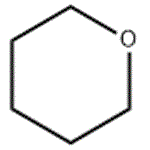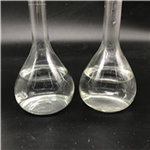Tetrahydropyran: Applications in Medicinal Chemistry and Preparation Method
May 16,2024
General Description
Tetrahydropyran plays a crucial role in medicinal chemistry, especially in developing antitumor agents. Studies have shown their significant chemical reactivity and antitumor activity, with modifications impacting their efficacy. The synthesis of novel compounds like carmethizole derivatives and tetrahydroisoquinoline benzodiazepine dimers has led to promising results in targeting cancer cells. Additionally, the conjugation of these derivatives to antibodies has shown potential in creating targeted anticancer therapies. The preparation method for tetrahydropyran involves controlled hydrogenation of alkoxydihydrofurans or alkoxytetrahydrofurans using specific reagents and conditions, resulting in high yields of the final product.

Figure 1. Tetrahydropyran
Applications in Medicinal Chemistry
Tetrahydropyran is a versatile compound with diverse applications in medicinal chemistry, particularly in the development of antitumor agents. Tetrahydropyran derivatives have shown promising results in various studies, exhibiting significant chemical reactivity and antitumor activity both in vitro and in vivo. Tetrahydropyran-based compounds were synthesized and evaluated for their potential as antitumor agents. One study focused on analogs of carmethizole hydrochloride, an experimental acylated vinylogous carbinolamine tumor inhibitor. These analogs were systematically modified, and their chemical reactivity as electrophiles was assessed. The study found that alterations in the alkylthio moiety of the compounds had a profound impact on their chemical reactivity and antitumor activity. Specifically, electron-withdrawing groups on the sulfur atom decreased both chemical reactivity and antitumor activity.
Furthermore, Tetrahydropyran derivatives were conjugated to antibodies targeting specific cancer biomarkers, resulting in antibody-drug conjugates (ADCs). These ADCs exhibited significant cytotoxicity and target-mediated selectivity in vitro, demonstrating their potential as targeted anticancer therapies. Moreover, in animal models of gastric and lung cancer, these ADCs showed consistent pharmacokinetic profiles and robust antitumor activity after a single dose, highlighting their therapeutic potential in vivo. Overall, these studies underscore the versatility and promise of Tetrahydropyran derivatives in medicinal chemistry, particularly in the development of novel antitumor agents with enhanced efficacy and target specificity. 1
Preparation Method
The preparation method for tetrahydropyran involves the hydrogenation of alkoxydihydrofurans or alkoxytetrahydrofurans. The process consists of several stages employing specific reagents, catalysts, solvents, and conditions. In the first stage, hydrogen gas is used along with palladium catalyst under certain conditions, typically at room temperature and pressure (1.5 hours, 0.8 MPa, rt). This step initiates the hydrogenation process. The second stage involves the addition of sodium bisulfate monohydrate and continuation of hydrogenation under varied temperature conditions (70°C for 2 hours, 100°C for 2 hours, and 130°C for 1.5 hours) while maintaining pressure (0.8 MPa). This step further promotes the hydrogenation reaction. An experimental procedure exemplifies the process. In a stainless steel autoclave, a specified amount of alkoxydihydrofuran is combined with a palladium catalyst (Pd/C) and hydrogen gas. The mixture is stirred at room temperature under hydrogen pressure. After the initial hydrogenation step, sodium hydrogen sulfate hydrate is added, adjusting the pH, and the reaction continues at elevated temperatures, with hydrogen continually introduced. The final product, tetrahydropyran, is obtained with high yields. For instance, in one experiment, tetrahydro-2-methoxy-2H-pyran was produced at a yield of 96%, while tetrahydro-2-butoxy-2H-pyran was obtained with a yield of 95%. Overall, the preparation method of tetrahydropyran involves controlled hydrogenation of alkoxydihydrofurans or alkoxytetrahydrofurans using palladium catalysts and specific temperature and pressure conditions to yield tetrahydropyran compounds efficiently. 2
Reference
1. Chowdari NS, Zhang Y, McDonald I, et al. Design, Synthesis, and Structure-Activity Relationships of Novel Tetrahydroisoquinolino Benzodiazepine Dimer Antitumor Agents and Their Application in Antibody-Drug Conjugates. J Med Chem. 2020; 63(22): 13913-13950.
2. Yamagami I, Yasuda H. Process for preparation of tetrahydropyrans via hydrogenation of alkoxydihydrofurans or alkoxytetrahydrofurans. 2006; WO2006062211.
- Related articles
- Related Qustion
- Tetrahydropyran: properties, applications and safety Dec 19, 2023
Tetrahydropyran is a versatile pharmaceutical intermediate with applications in the synthesis of bioactive molecules, despite being flammable and potentially hazardous.
- What is Tetrahydropyran? Oct 16, 2023
Tetrahydropyran is useful synthons for biologically important compounds. Its derivatives are widely used.
Potassium phosphate tribasic has versatile applications, but requires careful handling due to its potential side effects in medication.....
May 16,2024APIDibutyl phthalate, a common plasticizer, has significant antiandrogenic effects, impacting maternal health, fetal development, and reproductive outcomes in studies on pregnant rats.....
May 16,2024APITetrahydropyran
142-68-7You may like
- Tetrahydropyran
-

- $1.10 / 1g
- 2023-07-27
- CAS:142-68-7
- Min. Order: 1g
- Purity: 99.0% Min
- Supply Ability: 100 Tons
- Tetrahydropyran
-

- $0.00 / 25KG
- 2023-07-27
- CAS:142-68-7
- Min. Order: 1KG
- Purity: 99%
- Supply Ability: 50000KG/month
- Tetrahydropyran
-

- $10.00 / 1KG
- 2021-11-13
- CAS:142-68-7
- Min. Order: 1KG
- Purity: 99%
- Supply Ability: 5tons




